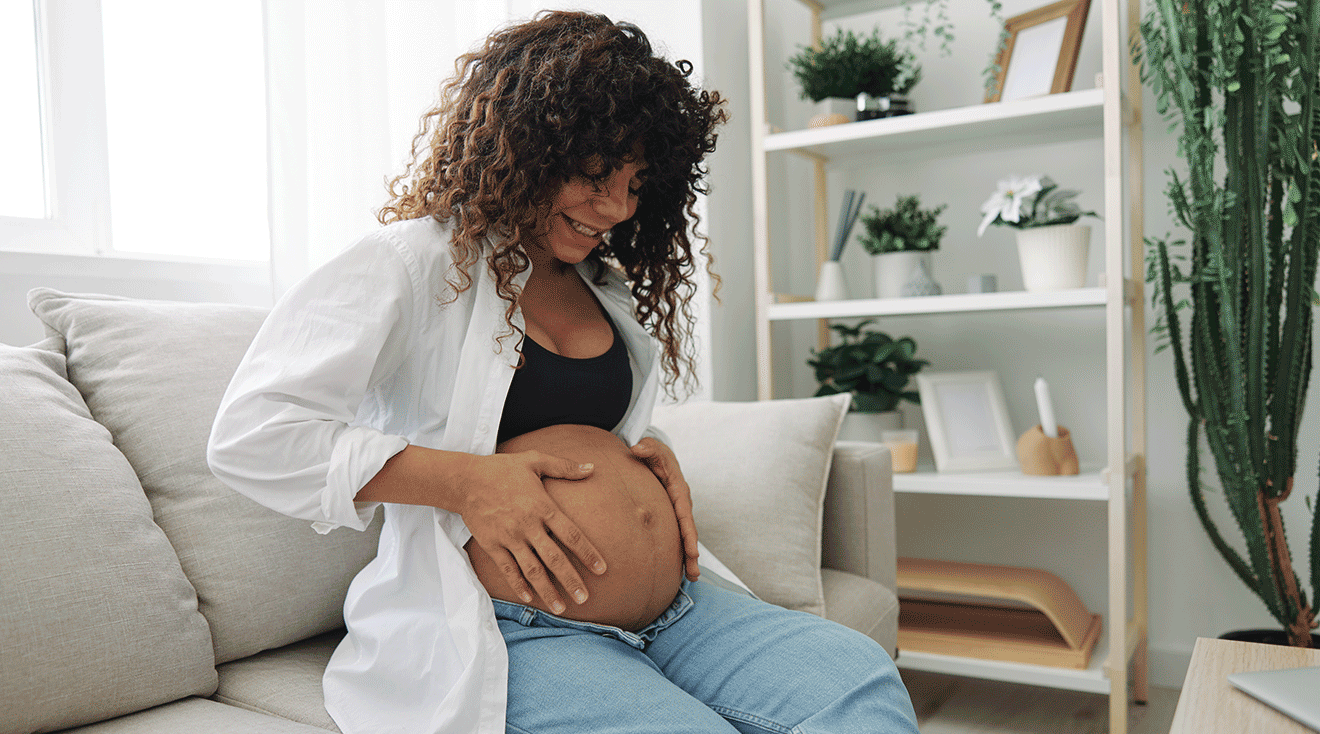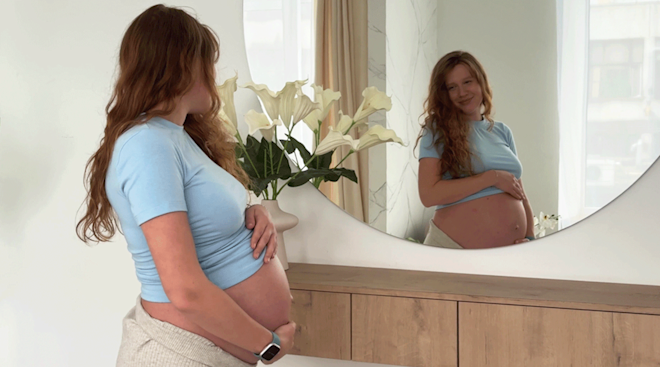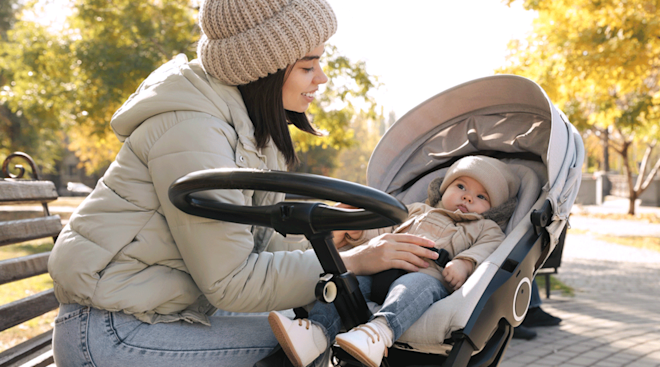7 Ways to Get Baby to Move in Utero
Feeling baby move in utero is a unique and incredible part of pregnancy. A few weeks into the second trimester, you may start to notice those signature butterfly motions, wiggles and squirms. But, like with so many things, it can take moms-to-be and pregnant people some time to understand baby’s movements and predict their patterns (especially since babies spend most of their time in the womb sleeping). Until then, you might wonder how to get baby to move in utero. It’s important to remember that each baby will respond differently to various methods of stimulation. Luckily, there are some easy and universally proven ways to get baby to move. Keep reading as experts walk us through some strategies.
Wondering how to make baby move in utero? The most effective way to get baby to move in utero is to eat or drink something with a moderate natural sugar content. The increase in Mom’s blood sugar often increases baby’s alertness and encourages them to move around. “You may notice more fetal movement right after eating a meal when Mom’s sugar or glucose levels are high,” explains Sherry Ross, MD, an ob-gyn and women’s sexual health expert. Some examples of food to eat include a piece of fruit, a glass of juice or another snack, like peanut butter, cheese and crackers. If you’re dealing with gestational diabetes, speak with your provider on the best food options for you.
Lying down on your left side during pregnancy is often recommended by experts and can help baby to move about in several ways. Just as they do after birth, babies experience wake and sleep cycles while they’re in the womb, and your movements throughout the day can help lull babies to sleep. It comes as no surprise then that babies may perk up during the times of the day you’ll be lying down to rest. In fact, studies have found that babies are typically most active between the hours of 9 p.m. and 1 a.m, Ross says. (However, the American Pregnancy Association also attributes this window to declining blood sugar levels, which can also prompt baby to move around.)
Lying down on your side also increases blood flow to baby, which can encourage movement, Ross adds. Moreover, while you’re up and moving around it can be easier to miss some of baby’s smaller, more subtle movements. But lying down can provide an opportunity to relax, connect with baby and feel all those little ways they’re saying hello.
Numerous studies have proven that babies can hear their environment within the womb—including their parents’ voice. According to the American College of Obstetricians and Gynecologists (ACOG), babies actually respond to familiar sounds, including parental voices, with movement starting around 7 months of pregnancy. So if you’re wondering how to make your baby move in the third trimester, try gently talking to them or singing them a lullaby.
Exercising during pregnancy has tons of research-backed benefits, including pain relief, stress management and improved neonatal health. But another benefit of working out during pregnancy is feeling baby move. A 2020 study found that baby’s heartbeat slightly increased with prenatal aerobic exercise, as did their movements. Wondering where to start? A moderate yoga flow and postures such as cat-cow help baby move in the womb, suggests Rebekah Mustaleski, CPM-TN, a certified professional midwife and compression director with Motif Medical,
Just like you can feel baby, baby can feel you. Research from the University of Utah has found that babies in utero tend to respond to Mom rubbing or stroking her bump. So, if you want to feel baby move, “don’t be afraid to give them a [gentle] nudge,” Mustaleski says. “Feeling your belly and interacting with baby is a great way to encourage movement and also connect with them before they’re born.”
Your touch isn’t the only thing baby can feel in the womb, they can also feel different temperatures. Both Mustaleski and Ross say that using something cold can often help wake baby in womb and get them to move around. Ross recommends drinking a glass of cold water (which will also help with those prenatal hydration goals!), while Mustaleski suggests using an ice pack or a pack of frozen peas and placing it wherever you feel baby’s head or back.
Not only can changing positions frequently—and paying attention to posture—keep you more comfortable as your bump grows, but it also enables baby to move to another position of their own, Mustaleski explains. “Babies often move to the spaces that have the least resistance.” If you want to feel baby move, try changing the leg that’s crossed, the side you’re laying on or another aspect of your placement. Ross also suggests changing positions to the left or right, moving to rest on all fours and doing pelvic tilts to get baby to move.
You may have heard from loved ones that eating spicy foods and shining a flashlight on your bump are surefire ways to make baby move in the womb. While these may work for some, Ross says both are nothing more than urban legends. A 2011 study found that eating spicy foods may help promote intestinal activity, but there’s no proof it’ll stimulate baby to move. As for shining a flashlight, studies have found that babies can detect light as early as the second trimester in the womb. While baby may respond to you shining a flashlight on your belly, a much more reliable way to get them to move around is by eating a snack or changing up your position.
Frequently Asked Questions
When do babies start moving in the womb?
“Babies are active in utero long before you’ll feel them,” Mustaleski says, noting that babies usually start moving their limbs in utero around 12 weeks gestation. “This movement is good for their developing body and muscles,” she adds. In terms of when you’ll start to feel baby move, Ross says it’ll probably happen between 18 and 21 weeks for a first pregnancy and sooner—between 14 and 16 weeks—for subsequent pregnancies. “Early fetal movement is most commonly experienced when a mom is sitting or lying quietly and concentrating on her body,” Ross explains. “It’s usually described as a tickle or feathery feeling below the belly button.”
How often should I feel baby move?
According to Mustaleski, baby’s movements will be inconsistent when you first start to feel them, but they’ll become more predictable by 24 weeks. “Those movements will continue to feel stronger as baby grows,” she notes, particularly in the second trimester. However, closer to term, around 36 weeks, you might notice baby’s movements becoming softer and slightly less noticeable. “That’s because at the end of your pregnancy, baby starts to run out of room in there,” Mustaleski adds. “There isn’t as much space for them to pull back for big kicks and so when they move it feels more like shifting or rolling.” Even so, it’s important to track baby’s movements in the third trimester, as it’ll help you set a benchmark for what’s normal and what’s not.
When should I worry about baby not moving?
If you haven’t felt baby move in a few hours, Ross says baby is probably sleeping and recommends drinking or eating something to help them move. “There’s a good chance baby will move with a sugar and hydration boost,” she says. However, if they don’t move after a couple of hours, if you don’t feel baby moving during their usual wake times or if baby’s kick counts are taking much longer than average, don’t hesitate to reach out to your provider. “I tell my clients to call if baby’s movements are decreasing,” Mustaleski says. This allows your provider to complete any follow-up work needed and ensure baby’s okay. Ross notes this is crucial after 36 weeks, as a lack of fetal movement could correlate with baby’s well-being.
Why does baby move on some days but not others?
“Babies actually move every day—you just don’t always feel it,” Mustaleski explains. Plus, how often you feel baby can depend on where your placenta is (i.e. if you have an anterior placenta) and what position baby’s in (i.e. breech or upside down), Ross adds.
Can I get baby to move into a more comfortable place?
Any of the listed methods above will work to move baby off of Mom’s bladder and intestines, the experts say, including eating or drinking something sweet and cold and changing positions.
Can I help baby drop down into the pelvis?
Both experts note that, unfortunately, there isn’t much you can do to help baby drop down into the pelvis. They’ll do so on their own once they’re ready as your body starts getting ready for labor. However, you can ensure the muscles and ligaments in your pelvis are loose and aligned. Mustaleski recommends doing hip circles on a birth ball, as well as cat-cow poses to ease tension in the lower back, hips and pelvic floor. “The best way to naturally help baby drop down into the pelvis is exercising regularly, doing squats and being active,” Ross adds. “There are no guarantees, but it doesn’t hurt to stay active.”
Ultimately, as you get used to baby’s movements, you’ll start to see a pattern in what is and isn’t effective. “Even before they’re born, babies have their own personalities and preferences,” Mustaleski says. “While some babies may get really excited about spicy foods, others may not. Some babies will have a tendency to fall asleep when you exercise (like they’ve been rocked to sleep) and others might feel like they’re exercising right along with you. Hopefully as you progress through your pregnancy, you’ll get to know baby and be able to identify the things that get them moving.”
Please note: The Bump and the materials and information it contains are not intended to, and do not constitute, medical or other health advice or diagnosis and should not be used as such. You should always consult with a qualified physician or health professional about your specific circumstances.
Plus, more from The Bump:
Rebekah Mustaleski, CPM-TN, IBCLC, is a certified professional midwife specializing in evidence-based maternity care. She co-founded Roots & Wings Midwifery in Knoxville, Tennessee. Mustaleski received her bachelor’s degree in psychology from Centre College and worked as a doula and birth photographer prior to establishing Roots & Wings.
Sherry Ross, MD, is an ob-gyn, women’s sexual health expert and author of She-ology: The Definitive Guide to Women’s Intimate Health. Period. and She-ology, The She-quel: Let’s Continue the Conversation. She earned her medical degree from New York Medical College.
American Pregnancy Association, Counting Baby Kicks
Developmental Science, Prenatal auditory experience and its sequelae, May 2022
PNAS, Learning-induced neural plasticity of speech processing before birth, August 2013
American College of Obstetricians and Gynecologists, Changes During Pregnancy
BMJ Open Sport & Exercise Medicine, Spotlight on the fetus: how physical activity during pregnancy influences fetal health: a narrative review, March 2020
University of Utah, UNBORN BABIES RESPOND TO MOTHER'S TOUCH, July 2015
Ohio State University, Pregnancy: Walking, sex and spicy food are favored unprescribed methods to bring on labor, June 2011
University of California-Berkeley, Babies in the womb may see more than we thought, November 2019
Learn how we ensure the accuracy of our content through our editorial and medical review process.
Navigate forward to interact with the calendar and select a date. Press the question mark key to get the keyboard shortcuts for changing dates.





















































